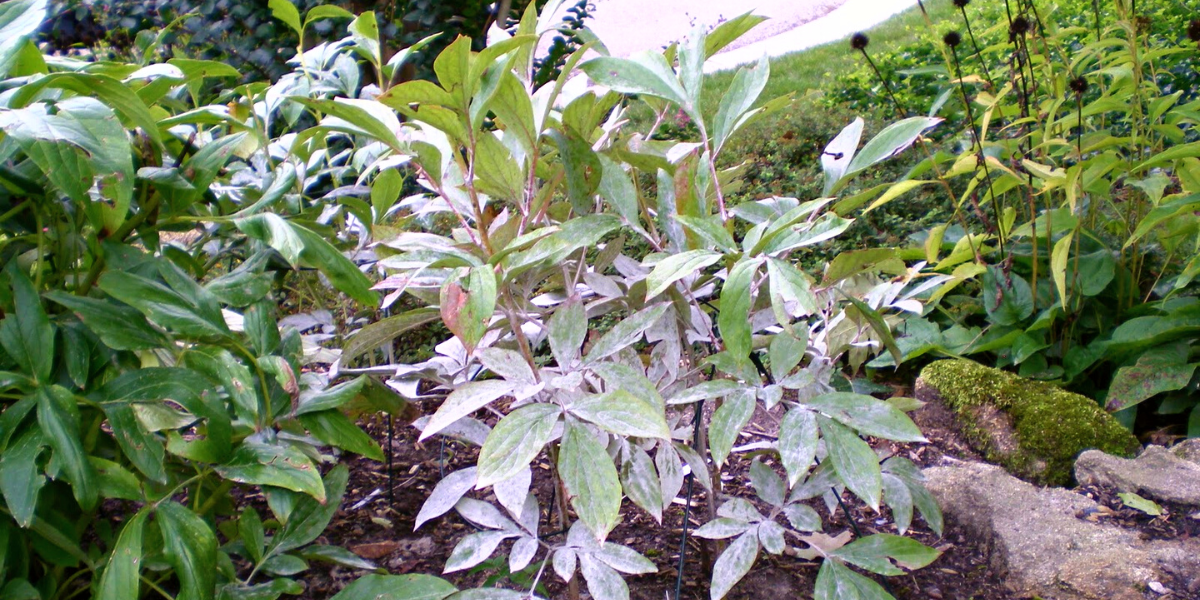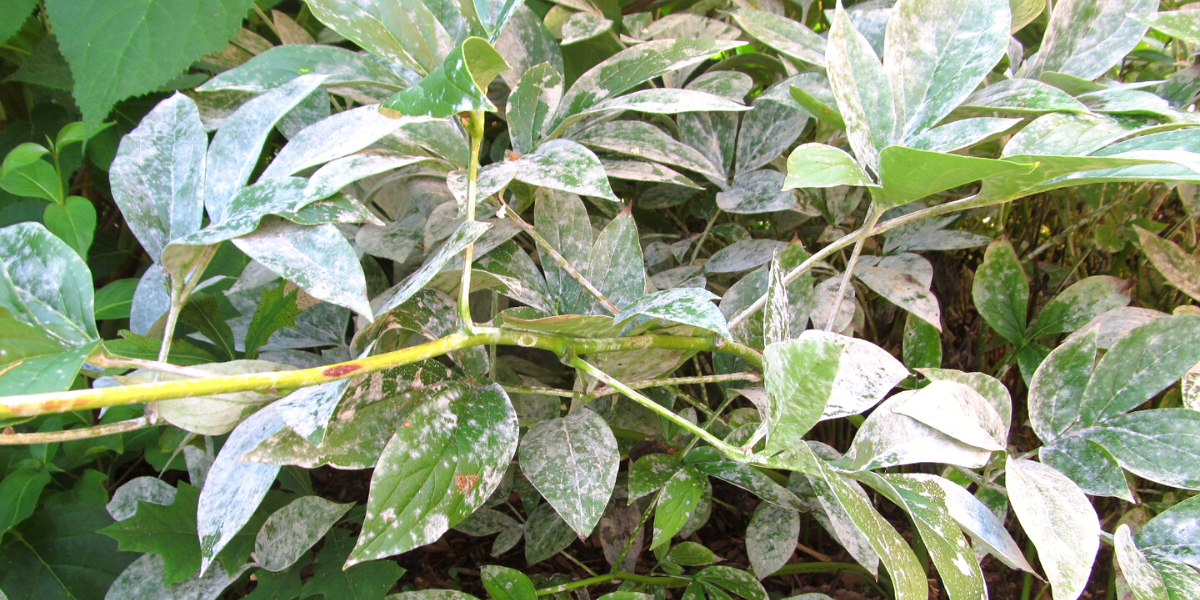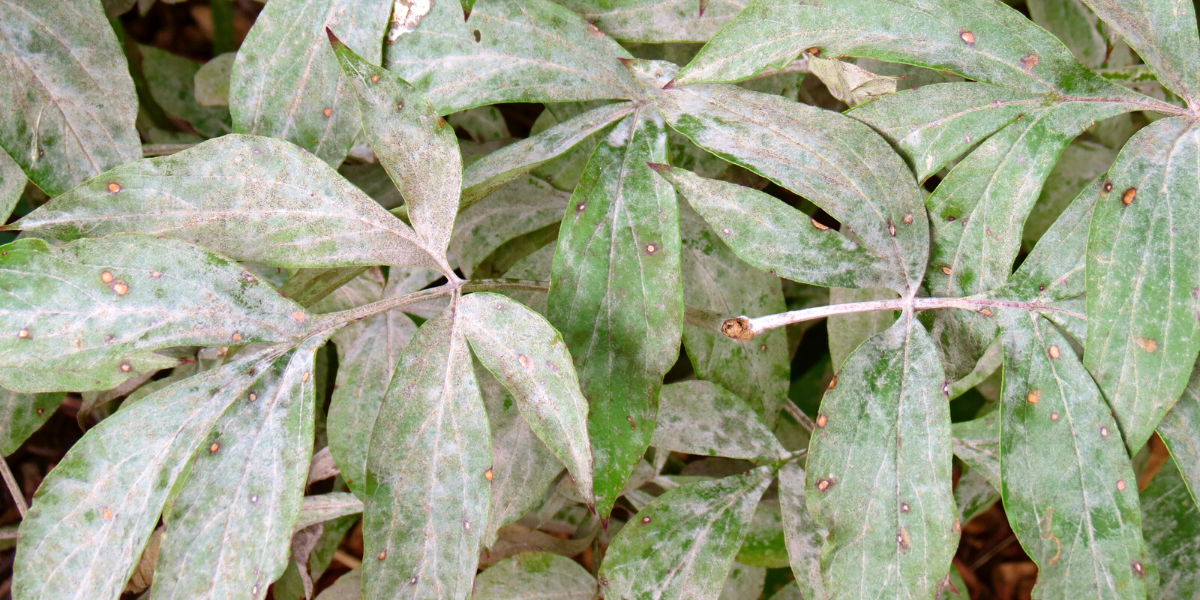Powdery mildew is a problem that many gardeners are familiar with and wish they were not. This is a disease that affects a wide range of plants, and the much-loved perennial peony, prized for its long life and attractive appearance, is unfortunately not resistant to it.
There are many questions about powdery mildew that largely go unanswered. How harmful is it, and is it necessary to take action whenever you see ugly white powder on a plant’s leaves? Will it spread if you leave things as they are and merely hope for the better? What’s a gardener’s best bet when it comes to getting rid of the nasty mould?
We brought to you this article in order to explore the many aspects of powdery mildew in peonies. You’ll also find out how to break the disease cycle by effectively combining natural treatment and a healthy gardening routine as well as how to prevent the affliction from spreading. You’ll also learn the causes of peonies plant diseases that involve white spots on the leaves and/or steams as well as how to differentiate between those.
Where Does Mildew on Peonies Come From?
Our knowledge of plant diseases has evolved over time, eliminating common misconceptions about their nature. You might have heard that it’s bacteria that causes flowers to develop nasty-looking white spots on their leaves which look somewhat fluffy and a lot like the notorious downy mildew you’ve probably seen on grapes. This has little to do with the truth, however.

When it comes to powdery white marks on your peonies, you’d better blame fungi and not bacteria. Biologically speaking, the term encompasses a wide variety of organisms, typically small, that don’t fit in either the plant kingdom or the animal one. Mushrooms are one notable example of fungi, but the classification also includes mildews, yeasts, and more. If a plant in your garden shows weird spots on its leaves, the chances are high that some type of fungi is to blame. This article deals specifically with the species that cause powdery mildew. We use species in plural because there’s more than one variety of fungi that can cover a plant in off-white powder.
The reason mildew-causing fungi are likely to take residence in your flower garden is that they can only feed off a plant host. That is, they won’t be able to thrive and reproduce unless they lead their parasitic lifestyle on your peonies or roses. Before we focus on powdery mildew control measures, it’s essential that we understand what condition it looks for naturally.
Powdery mildew fungi tend to choose shady places that are humid and don’t have good air circulation. This is often the case around the roots of bushy or densely growing plants. The species are capable of creating so-called mycelial mats that can overwinter in unopened flower buds as well as on leaves and stems. When the weather becomes warmer and more humid, especially when the night offers a bit of cool, the dormant mildew will start spreading its conidia, or spores. These structures are the primary instrument on which mildew relies for reproducing, and they will easily attach to other plant tissues nearby as they travel with the wind. Unfortunately, growing your flowers in a greenhouse does not prevent the distribution of powdery mildew; the setting is in fact even more prone to air circulation issues.
How innocent is it?
Powdery mildew is rather common in peonies as well as other flower species. It’s definitely not the deadliest of plant diseases, but it does require special care when it occurs in your garden. It’s a popular opinion that the powdery white spots are more of an eyesore than a real problem, in reality, the mildew feeds on the host, thus inevitably undermining its vigor. You are unlikely to see any dramatic changes until it gets really advanced, there. It’s not uncommon to see mildew-plagued gardens that “don’t look that bad” for a while.
The bad news is that, given the quick and easy transmission mechanism as well as the fungus’s ability to overwinter in flower buds, the infection isn’t likely to pass without any cure. You’ll need at least to look closely at your gardening habits to make sure it doesn’t catch on. Severe cases may require the use of chemical treatment as the last resort, or you run the risk of losing the rest of your garden to the disease. When overlooked for a long time or combined with other problems, powdery mildew can inhibit growth and flowering in peonies and disfigure the plants aesthetically.
How to Diagnose Mold on Peonies
It usually starts with a suspicious mark on a leaf or a generally bleak, wilted look. When you look closely, you find that the whitish spots are powdery in texture, just like kitchen salt but not that sharp and crystal-like. Yet, the variety of mildew that potentially affect peonies suggests that you take a number of extra steps before you can claim you have powdery mildew. Here’s a quick guide on what to do if you have spotted a sick-looking plant in your garden.

Visual Inspection
It’s generally good practice to make rounds every once in a while, look at your peonies to make sure they are healthy. Pay special attention to the following:
- Any discoloration on the leaves. If you see glossy brown patches, this is probably caused by peony leaf blotch, another fungus that uses peonies as its hosts. By contrast, powdery mildew is white or off-white. Check the texture; if it reminds you of what it was named after, you are probably right in your suspicion.
- Do not limit the inspection to the leafy part of your peonies. The stems can be affected as well. In this case, the mould may be denser, less fluffy, and a bit darker.
- When the damage is really heavy, dark lesions may appear on the affected areas. Look for less dramatic pictures around to find out which mildew is to blame.
Specialized Software
Identifying powdery mildew on peonies can be a tough task. This is where our application might come in handy as it can help you diagnose the flower disease you are dealing with based on the plant’s appearance. All you need to do is take a picture with your camera and let the app do its job. It relies on an excellent pool of data on flora and plant diseases, so diagnosing a problem as common as powdery mildew on your peonies shouldn’t be difficult.
Getting Rid of the Eyesore
When you have identified the problem for sure, it’s time to decide what action might be appropriate in this particular situation. Fungal diseases are notorious for being hard to control, and powdery mildew is no exception. This is partly what causes gardeners to give up on their peonies whenever they see the characteristic fluffy coat of mould on their leaves.
As you have probably read above, however, this infection is not so harmless as to pretend it’s not there. You’ll need to work out a plan to keep it and, possibly, other types of mildew in your garden in check. The easiest place to start is prevention, which might be enough in case of slight to moderate local problems.
Preventative treatment
Creating unfavorable conditions for pathogenic fungi in your garden or greenhouse should be your primary goal as a peony breeder or an amateur green thumb overall. This includes fulfilling the following requirements:
- ensuring free air circulation within masses of foliage as well as between plants;
- providing the flowers with sufficient sunlight;
- preventing the accumulation of water on leaves as well as in indentations on peony stems;
- making sure the mildew, if any, won’t be able to overwinter on your plants.
Pruning should be part and parcel of peony care. It applies not just to this flower species but to other plants as well; the idea is to space individual bushes adequately and thin out the foliage every once in a while to prevent it from getting too dense. If you miss the opportunity to do it, you’ll probably end up with too much shade. This is welcoming to most fungi, which are usually afraid of direct sunlight, and also hampers the flow of air.
Watering methods matter when it comes to mildew management. You’ll often read that overhead watering is counterindicated whenever there’s a risk of mildew development. This is not entirely wrong because such this approach tends to leave a lot of moist on the leaves and petals of peonies. It can in turn cause powdery mildew and other fungi to occupy the plant. However, there’s an exception to this rule. Overhead watering can be an effective treatment for powdery mildew provided that the infestation isn’t too massive and there’s enough heat and sunshine for any excess moist to evaporate soon.
Investing in mildew-resistant cultivars
If you have a habit of flipping through seed catalogs, you have probably noticed that some plants are advertised as being especially sturdy, often specifically in respect to certain diseases. Some are said to be insusceptible to powdery mildew. There are peony cultivars that boast this epithet, which makes them a safer bet compared to the average variety but still does not exclude the possibility of contracting the fungus.
While it’s true that some plants have the right genetic disposition to resist fungal and/or bacterial invasion, it doesn’t guarantee success. This is because organisms such as fungi will also evolve to make sure they have a firm grip on their potential host, without which they won’t be able to exist. That is, this preventive measure works best in combination with other techniques.
Natural remedies for white powder on peony leaves
There’s a general tendency today to stay away from harsh, artificially produced chemicals when it comes to treating plant diseases. You can support the eco-awareness trend and choose less toxic natural products that can still keep mildew at bay. One of the most notable examples on the market today is neem oil.

Made from a South Asian decorative tree, neem oil is a popular ingredient in organic farming formulations and is known to help against mildew in a number of plants. Several neem oil-based products have been approved as organic fungicides. Apart from that, the oil is believed to have an insecticidal effect, which means it can help you get rid of pest insects plaguing your garden. All this comes at nearly no cost to the plant compared to harsher commercial solutions.
Another easy-to-implement DIY solution to powdery mildew is mixing baking soda with vinegar and sprinkling your peonies. Just like with neem oil formulations, it’s essential that you don’t leave the plant wet.
Best chemical solutions
In really dramatic cases when you feel like you can’t entrust this mission to gentler methods, commercial fungicides are there to destroy the mildew. Just like other solutions, these work best as prevention and can be combined with organic substances such as neem or canola oil for more impressive results.
One of the most common fungicides for powdery mildew control in peonies is Chlorothalonil, which goes under a number of commercial names. It’s common practice to apply it to new growth in spring as a proactive measure to prevent fungal infections in peonies as well as other flowers. Remember to always follow the instructions for the specific product you have chosen when using such substances.
Protect Your Peonies Proactively
Powdery mildew is a potentially disfiguring fungal disease that affects a large number of plants including peonies. Despite its characteristic appearance which gave it its name, the condition may not be easy to diagnose unless you have extensive experience with it, which is why we recommend double-checking your findings with our application. This should be your first step towards protecting your flower garden from further spreading of the disease.
Prevention is definitely easier and better than cure when it comes to powdery mildew. Adopt a healthy peony care routine that includes regular pruning and watering in moderation, make sure the plants you buy are relatively resistant to pathogenic fungi, and only resort to chemical treatment as the last resort.
Have you ever faced powdery mildew in your garden? How did you identify it? Share in the comments.
Leave a Reply
You must be logged in to post a comment.